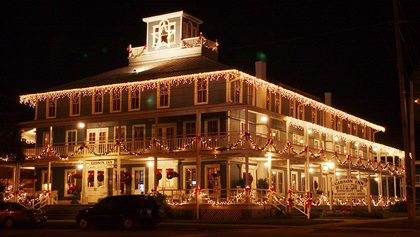History and charm on 'The Forgotten Coast'
Apalachicola, Florida
If you’re looking for a destination with “old Florida” history and charm, program your GPS for Apalachicola.
This historical river port with a working waterfront and no high-rise condos offers visitors a unique look back in time, with more than 250 listings on the National Register of Historic Places.
Sidewheel steamboats navigating the Apalachicola River carried cotton shipped south from Georgia and Alabama for export to worldwide destinations. And, after the Civil War, shipping lumber that was harvested locally became a major business.
Oyster Town
Seafood and sponges were also an important part of the local economy. Often called “Oyster Town,” Apalachicola is known as the oyster capital of the world because 90 percent of Florida’s oyster production once came from the nearby Apalachicola Bay estuary.
However, a 2012 drought and a “water war” with Georgia changed the bay’s ratio of fresh and salt water that is critical to producing the area’s famous plump oysters. In 2020 a five-year moratorium was imposed on oyster harvesting.
Local restaurants still feature fresh oysters, but now they’re imported from Louisiana and Texas. Fish, shrimp, and blue crab round out many menus.
A 1900 fire destroyed much of downtown Apalachicola, and many of the buildings in use today date from a period of rebuilding around 120 years ago.
After railroads impacted its export trade, the city became isolated and fell on hard times. Fortunately, the homes of wealthy lumber barons and the downtown’s wide streets and squares, which were originally modeled on Philadelphia, were left largely undisturbed and ripe for restoration over the past few years.
Unique places to stay

Apalachicola’s downtown is walkable and numerous overnight accommodations, shops, and restaurants are housed in restored buildings. Refreshingly, the only chain motel is a Best Western and a wide variety of unique properties are available through Airbnb and VRBO.
The Gibson Inn, located downtown and dating from 1907, is the best-known boutique hotel in the area. Under new ownership since just before Hurricane Michael hit in 2018, a restoration of the 45-room property is almost complete. The new owner grew up vacationing there with his family.
Although Apalachicola experienced significant hurricane storm surge flooding, the damage was nothing like the devastation of Mexico Beach to the west, where many buildings were flattened.
Another unique Apalachicola lodging choice is The Consulate, a family-owned property that has four second-floor luxury suites with kitchens and a great view of the bay and Riverfront Park. Dating from the glory days of exports in the area, the building originally housed the French Consulate.
Today, the building’s first floor is occupied by the Grady Market, which features upscale casual clothing and accessories.
The Coombs Inn and Suites, dating from 1905 and furnished with period antiques, is composed of three elegant Victorian mansions with a total of 23 guest rooms.
If you’re looking for modern accommodations on the river, the Water Street Hotel and Marina has suites with balconies overlooking the water. Boat docks and a swimming pool make this property stand out. Another option for those wanting to be on the water downtown are several permanently moored houseboats available for rent.
If a rustic “fishing camp” experience is desired, check out Bay City Lodge, which has a marina and various types of accommodations, including a lodge building with six bedrooms that will sleep 15 guests. Cabins and motel rooms are also available. Fishing guides can be booked through the lodge and a restaurant on the property will cook the fish you catch. Red snapper season is in June and July.
Come hungry
An opportunity to sample numerous local restaurants is one of the main reasons pilots visit Apalachicola. The Owl Café is a downtown favorite when the Southeast Bonanza Society holds a fly-in lunch. The Franklin Café at the Gibson Inn is also popular, as is the Oyster City Brewing Company's brew pub nearby. The Up the Creek Raw Bar is recommended by locals and Apalachicola Seafood Grill, established in 1903, is famous for the “world’s largest fish sandwich.”
Lots of shopping
Although some stores are closed on Sunday, shopping in Apalachicola’s walkable downtown area is a popular activity, with almost every boutique retail option represented, including clothing, gifts, books, jewelry, art, and fishing gear. The most unique establishment is The Tin Shed Nautical and Antiques, where you can find funky vintage maritime items ranging from driftwood and colorful lobster pot buoys to carved wood mermaids and brass diving helmets.
Museums
Two pre-Civil War houses in Apalachicola are open for tours. The Orman House Historic State Park park is the top-rated attraction by Trip Advisor, followed by the Raney House Museum. There is also the Apalachicola Center for History, Culture, and Art and the John Gorrie Museum, which displays a scale model of the world’s first ice making machine, which was patented in 1851. A local physician, Dr. Gorrie invented refrigeration to cool his yellow fever patients.
Nearby beaches
Apalachicola is not a beach town, but St. George Island is just 15 minutes away by car. Driving east over a long, sweeping bridge leads to the 28-mile barrier island, which offers the typical beach house accommodations. Other popular beaches in the area are Cape San Blas and Port St. Joe. Black’s Island is a nearby private resort accessible by boat or helicopter.
Despite the pandemic, Franklin County, where Apalachicola and St. George Island are located, had a record year for tourism in 2020 and the trend is expected to continue once the virus is under control. Weekend festivals are a favorite of visitors and several are on the calendar.



